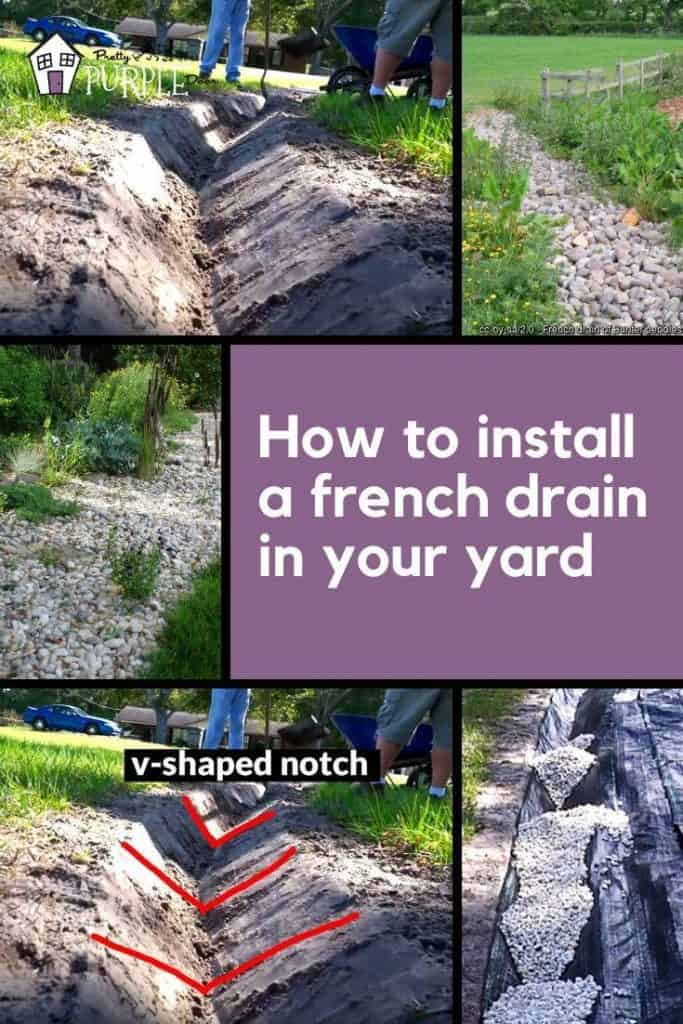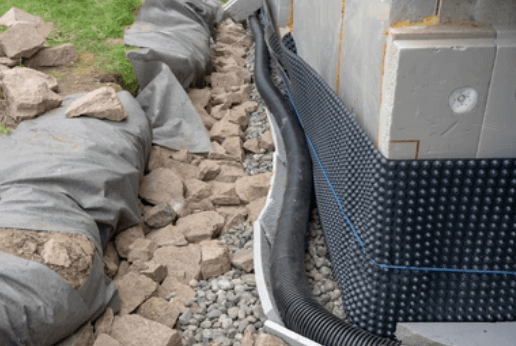Clues Your Home Needs a Portland French Drain ASAP
Clues Your Home Needs a Portland French Drain ASAP
Blog Article
The Crucial Overview to Keeping Your French Drain for Long-Lasting Performance
Maintaining your French drain is key to its performance and your building's defense. Normal checks can conserve you from expensive repair services and water damage. You'll wish to know what signs to look for and just how often to evaluate your system. And also, comprehending the cleaning process can make a significant difference. Let's explore the essential actions for guaranteeing your drain operates well for several years to find.
Comprehending the Feature of a French Drainpipe
A French drain is a crucial component in taking care of water around your home. It guides excess water away from your structure, protecting against flooding and damage. When hefty rain drops, the drainpipe collects water via a perforated pipeline buried in gravel. This system enables water to flow openly, lowering stress on your basement wall surfaces and reducing the threat of leaks.You may ask yourself exactly how it functions in practice. As water saturates the dirt, gravity pulls it toward the drainpipe. The perforated pipe catches this water, carrying it to a designated water drainage area or tornado sewer. This procedure keeps your yard completely dry and safeguards your home's architectural integrity.Understanding how a French drainpipe functions is crucial to appreciating its value. By successfully directing water away, it aids maintain a risk-free and completely dry living environment. Maintaining your French drainpipe in leading condition guarantees you stay clear of expensive repairs down the line.
Routine Inspections: What to Search for
Begin by examining for any blockages that may be blocking water circulation when you're examining your French drain. Take note of indicators of surface area disintegration around the drainpipe, as this can show potential issues. Routine evaluations will assist maintain your drain system operating effectively.
Clogged Drain Assessment
Just how can you inform if your French drainpipe is obstructed? Initially, watch for water pooling in your lawn, particularly after heavy rain. If you observe locations where water gathers rather than draining, that's a warning. You ought to also check the drainpipe electrical outlet; if water isn't spurting as it should, there's likely a blockage. Listen for uncommon gurgling audios, which can suggest trapped air. Furthermore, examine the drain's surface area for any type of vegetation development, as origins can infiltrate and obstruct the system. Lastly, if you scent stuffy smells, it might indicate stagnant water brought on by a blockage. On a regular basis reviewing these signs can help you keep your French drain efficiently and prevent pricey repair services.
Surface Area Disintegration Check

Cleaning Your French Drainpipe: Step-by-Step Guide
Cleaning your French drain is necessary for keeping it working appropriately. You'll require some certain tools and a clear process to assure whatever runs smoothly. Let's go through the steps and ideas for maintaining your drainpipe successfully.
Tools You'll Require
To tackle the job of cleansing your French drainpipe properly, you'll want to collect a couple of necessary tools. Get a durable set of handwear covers to secure your hands from particles and sharp items. A little shovel or trowel will aid you remove dirt or obstructions around the drain. For removing the inside, a plumbing's snake or a high-pressure water nozzle can be incredibly beneficial. You'll additionally require a pail for gathering any type of particles you take out. Finally, having a yard hose pipe available will make it simpler to rinse out the drainpipe and ensure it's streaming smoothly. With these tools ready, you'll be established for a thorough cleansing session!
Cleansing Refine Steps
Begin by assessing the area around your French drain for any kind of noticeable debris or clogs. Remove fallen leaves, branches, or dust that might block water flow. Next off, inspect the inlet and outlet locations; clear any blockages to guarantee proper water drainage. Use a garden hose to flush the drainpipe, guiding water right into the inlet. This helps dislodge any accumulated sludge or debris. If you discover persistent clogs, take into consideration using a plumber's snake to break them up. After cleansing, check the gravel around the drainpipe; renew it if it's removed. Lastly, verify the drain covers are undamaged and securely in location to prevent particles from entering. Routine cleaning keeps your French drain working effectively.
Maintenance Frequency Tips
While routine upkeep is crucial for your French drainpipe's durability, recognizing exactly how frequently to maintain it can make all the distinction. Preferably, you need to evaluate your French drainpipe at the very least twice a year, preferably in spring and autumn. After hefty rainfall or snowmelt, check for obstructions or debris. If you discover any kind of standing water, it's time to clean your drain.In areas with heavy foliage, more frequent maintenance-- about every 3 months-- may be essential. Furthermore, think about cleaning your French drain after major tornados or if you observe water pooling in your lawn. By staying positive, you'll ensure your French drain features effectively and protects your residential or commercial property from water damages. Routine checks will conserve you money and time in the future.
Determining Usual Concerns and Their Solutions
When you see water merging in your backyard or damp areas in your cellar, it's crucial to determine usual problems with your French drainpipe and execute reliable remedies. One frequent problem is obstructing, typically triggered by debris like leaves or sediment. To repair this, you can use a pipes serpent or a high-pressure water jet to clear blockages.Another issue may be inappropriate slope. Water won't flow away from your home if your drainpipe isn't sloped appropriately. You can adjust the slope by excavating and rearranging the drain pipe.Lastly, look for damage or fractures in the drain itself. Replacing the harmed areas is important for peak performance if you find any type of. By resolving these issues promptly, you'll assist guarantee that your French drain proceeds to function properly, shielding your residential property from water damages and keeping a completely dry, secure environment.
Seasonal Maintenance Tips for Your French Drain
Resolving common problems with your French drainpipe is just the initial action in guaranteeing its long-term effectiveness. Seasonal upkeep is important for peak performance. In the spring, remove leaves and particles that might have built up during wintertime. Look for any obstructions in the outlet or catch container, as water needs a clear course to flow freely.During summertime, check your drain for any kind of indications of resolving or shifting dirt. Make sure it's still level and functioning correctly. As loss methods, tidy out any kind of fallen delegates stop clogs prior to wintertime arrives.In winter months, expect freezing temperatures. Make sure your drain isn't at threat of cold if you live in a cool environment. Protecting subjected pipelines can aid. Routine checks and prompt upkeep can stop pricey repair work and keep your French drainpipe working successfully year-round. Stay aggressive and appreciate peace of mind understanding your water drainage system is in good condition!
When to Employ an Expert
When to call in an expert can conserve you time and stop additional damages to your French drainpipe, visite site recognizing. If you see persistent standing water in your backyard, it's a clear indicator that your drain may be clogged or damaged. Do not overlook strange odors, as they can show sewer backup or decay, which needs immediate attention.If you find that your drainpipe isn't operating effectively after efforts to clean or preserve it, it's time to connect Check This Out for expert aid. Additionally, if you're uncertain regarding the underlying concerns or lack the essential tools, employing an expert can offer peace of mind.Finally, if your French drain is old or has experienced significant deterioration, expert assessment can determine whether repair work or total replacement is required. Count on the experts to guarantee your water drainage system functions efficiently for several years to find.
Tips for Avoiding Future Drain Troubles
To keep your French drain working effectively, consistently evaluating and maintaining it can make all the distinction. Begin by clearing debris, leaves, and dirt from the surface and drainpipe openings. This protects against obstructions that can cause water back-up. Check the crushed rock around the drainpipe; if it's compressed or worn down, think about including fresh gravel to preserve excellent flow.Next, draw away water away from your drain by guaranteeing gutters and downspouts are clear and guiding water a minimum of 3 feet away from your structure. Frequently check for any kind of indications of damages or sagging. If you notice issues, address them immediately.Finally, take into consideration installing a catch or a filter container to trap larger particles prior to it gets in the drain. By staying proactive with these suggestions, you'll lessen the risk of future drain troubles and keep your French drain in top shape.
Frequently Asked Inquiries
How Long Does a French Drain Commonly Last?
A French drainpipe commonly lasts around 30 to 40 years, depending upon the products used and maintenance (Portland French Drain). If you stay on top of routine checks, you can expand its lifespan also better
Can I Install a French Drainpipe Myself?
Yes, you can set up a French drain yourself if you've obtained the right tools and expertise. Simply make certain to prepare thoroughly, adhere to regional regulations, and guarantee appropriate drain to avoid future concerns.
What Materials Are Used in a French Drain?
You'll need perforated pipe, gravel, landscape textile, and a strong water drainage pipeline for your French drainpipe. These materials help redirect water efficiently, stopping flooding and keeping your home completely dry and risk-free from water damages.

Is a License Required to Install a French Drainpipe?
You'll likely need a permit to install a French drain, depending on regional laws. Consult your district to assure you abide by any type of essential standards and prevent prospective problems throughout setup.
What Are the Costs Related To French Drain Upkeep?
Keeping a French drainpipe generally costs in between $100 and $500 every year. You'll need to take into account expenditures for cleansing, fixings, and assessments. Regular maintenance aids prevent larger costs and assurances your system functions effectively for years - Portland French Drain. When you're checking your French drain, beginning by checking for any kind of clogs that might be blocking water useful link flow. By remaining proactive, you'll guarantee your French drainpipe features successfully and protects your building from water damages. When you see water merging in your yard or damp places in your basement, it's crucial to recognize common concerns with your French drain and execute effective options. You can change the incline by excavating and repositioning the drainpipe pipe.Lastly, check for damage or fractures in the drainpipe itself. Inspect the gravel around the drainpipe; if it's compressed or eroded, take into consideration including fresh crushed rock to preserve excellent flow.Next, draw away water away from your drainpipe by guaranteeing seamless gutters and downspouts are clear and directing water at the very least 3 feet away from your structure
Report this page